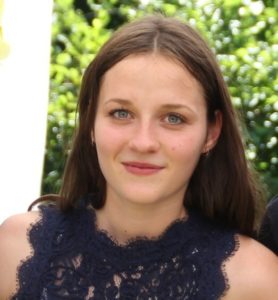Marie and the chemistry of ruthenium
In the fall of 2021, Marie Théry started a thesis at GIP ARRONAX to study the chemistry of Auger electron emitting elements, especially ruthenium.
 The first time Marie set foot in GIP ARRONAX, she was in L1 mathematics, physics and chemistry at the University of Nantes. At the time, I didn’t know what to do,” she recalls. Medicine and health attracted me: one of my professors took me on a tour of Arronax and I realized that radioactivity could be used to treat.”
The first time Marie set foot in GIP ARRONAX, she was in L1 mathematics, physics and chemistry at the University of Nantes. At the time, I didn’t know what to do,” she recalls. Medicine and health attracted me: one of my professors took me on a tour of Arronax and I realized that radioactivity could be used to treat.”
In L3 advanced chemistry, she returned for a voluntary internship. Then in M1 chemistry, option Analysis and Control of Biomolecules to Industrial Products (ACBPI), to work on the chemistry of scandium 44. “I did my M2 internship at the CEA to see something else, and I worked there on the radiolabeling of carbon 11 for the purpose of diagnosing neurodegenerative diseases. But when you love it, you always come back!” the PhD student laughs.
Marie, 24 years old, has chosen to undertake a thesis in radiochemistry at GIP ARRONAX, under the direction of Sandrine Huclier (Subatech laboratory). She is studying the chemistry of Auger electron emitting elements in order to contribute to the development of Auger therapy against cancer. This nuclear medicine approach, still in its infancy, could target more specifically the DNA in tumor cells, limiting the impact of radiation on the healthy cells around them. “One of the goals of my thesis is to contribute to the development of in vivo 103 Ru/103m Rh et 103 Pd/103m Rh generators,” continues the chemist. This requires a good understanding of the chemical properties of these elements. But ruthenium, little known as a waste product in nuclear reactors, is much less well known in nuclear medicine. It is a tricky element, with a complicated chemistry. There is a huge field to be explored, which is both exciting and dizzying.”
At first, Marie will work to qualify the behavior of ruthenium in solution, as well as its electrochemistry. Later, she will have to determine how to separate the different elements that make up the generators. The magnitude of the challenge is a bit daunting for her, as it has been for others before her: “I’m just getting used to working with my knowledge of different fields simultaneously. To operate like a researcher, in short.
Contact : Marie Théry

